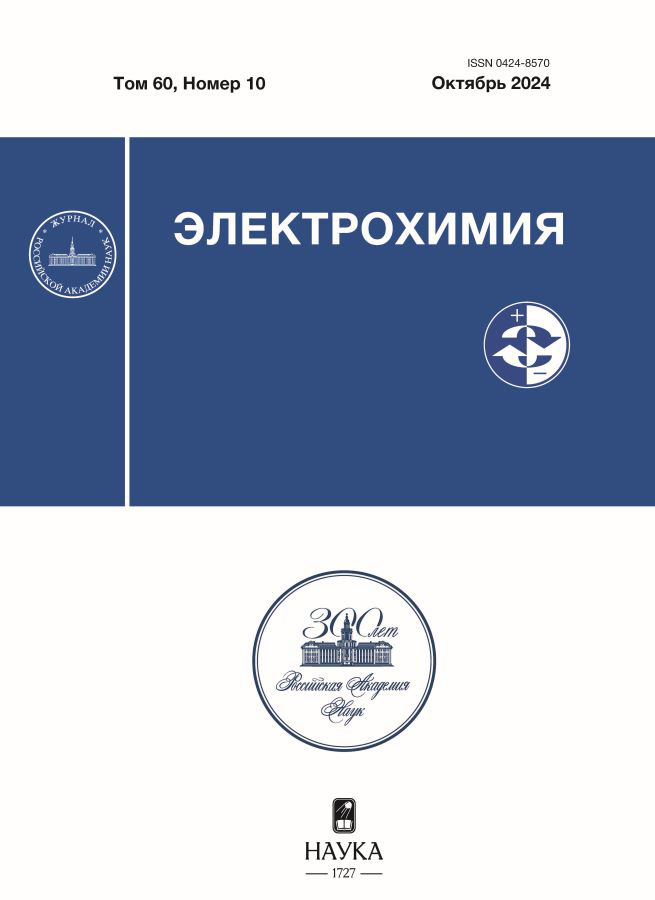The effect of TiO2 nanoparticles and the “liquid phase therapy” on the resistance of the interphase lithium/polymer electrolyte with the introduction of ionic liquid
- Authors: Baymuratova G.R.1, Yudina A.V.1, Khatmullina K.G.1,2, Slesarenko A.A.1, Yarmolenko O.V.1
-
Affiliations:
- FRC of Problems of Chemical Physics and Medicinal Chemistry RAS
- National Research University “Moscow Energy Institute”
- Issue: Vol 60, No 10 (2024): Спецвыпуск “Электрохимия-2023”, часть 1
- Pages: 706-711
- Section: Articles by participants of the All-Russian Conference “Electrochemistry-2023” (Moscow, October 23–26, 2023)
- URL: https://medjrf.com/0424-8570/article/view/677606
- DOI: https://doi.org/10.31857/S0424857024100042
- EDN: https://elibrary.ru/OHMEBT
- ID: 677606
Cite item
Abstract
The effect of treating a metal lithium surface with 1 M LiN(CF3SO2)2 solution in 1,3-dioxolane/1,2-dimethoxyethane (2:1) mixture on the resistance of the lithium/polymer and lithium/nanocomposite electrolyte based on the ionic liquid 1-ethyl-3-methylimidazolium tetrafluoroborate was studied. It has been shown that “liquid-phase therapy” reduces the resistance at the Li/electrolyte interface by 2.5 times at room temperature and expands the operating temperature range to –30°C. The introduction of TiO2 nanoparticles into the polymer electrolyte, along with “liquid-phase therapy” of both the cathode and the Li-anode, provides a high and stable discharge capacity of the Li//LiFePO4 battery for 100 charge-discharge cycles.
Full Text
About the authors
G. R. Baymuratova
FRC of Problems of Chemical Physics and Medicinal Chemistry RAS
Author for correspondence.
Email: guzalia.rb@yandex.ru
Russian Federation, Chernogolovka
A. V. Yudina
FRC of Problems of Chemical Physics and Medicinal Chemistry RAS
Email: oyarm@icp.ac.ru
Russian Federation, Chernogolovka
K. G. Khatmullina
FRC of Problems of Chemical Physics and Medicinal Chemistry RAS; National Research University “Moscow Energy Institute”
Email: guzalia.rb@yandex.ru
Russian Federation, Chernogolovka; Moscow
A. A. Slesarenko
FRC of Problems of Chemical Physics and Medicinal Chemistry RAS
Email: guzalia.rb@yandex.ru
Russian Federation, Chernogolovka
O. V. Yarmolenko
FRC of Problems of Chemical Physics and Medicinal Chemistry RAS
Email: oyarm@icp.ac.ru
Russian Federation, Chernogolovka
References
- Pei, Y., Zhang, Y., Ma, J., Fan, M., Zhang, S., and Wang, J., Ionic Liquids for Advanced Materials, Mater. Today Nano, 2022, vol. 17, p. 100159.
- Dong, K., Liu, X., Dong, H., Zhang, X., and Zhang, S., Multiscale Studies on Ionic Liquids, Chem. Rev., 2017, vol. 117, p. 6636.
- Chen, N., Zhang, H., Li, L., Chen, R., and Guo, S., Ionogel Electrolytes for High‐Performance Lithium Batteries: A Review, Adv. Energy Mater., 2018, vol. 8, p. 1702675.
- Watanabe, M., Thomas, M.L., Zhang, S., Ueno, K., Yasuda, T., and Dokko, K., Application of Ionic Liquids to Energy Storage and Conversion Materials and Devices, Chem. Rev., 2017, vol. 117, p. 7190.
- Yu, L. and Chen, G.Z., Ionic Liquid-Based Electrolytes for Supercapacitor and Supercapattery, Front. Chem., 2019, vol. 7, p. 272.
- Tripathi, A.K., Ionic Liquid–Based Solid Electrolytes (Ionogels) for Application in Rechargeable Lithium Battery, Mater. Today Energy, 2021, vol. 20, p. 100643.
- Correia, D.M., Fernandes, L.C., Martins, P.M., García‐Astrain, C., Costa, C.M., Reguera, J., and Lanceros‐Méndez, S., Ionic Liquid–Polymer Composites: A New Platform for Multifunctional Applications, Adv. Funct. Mater., 2020, vol. 30, p. 1909736.
- Qiu, C., Li, Z., Pan, J., Hong, Y., Li, J., Lin, Y., Shi, K., and Liu, Q., Designing Stable Electrode Interfaces from a Pyrrolidine-Based Electrolyte for Improving LiNi0.8 Co 0.1Mn0.1 O 2 Batteries, Ind. Eng. Chem. Res., 2022, vol. 61, p. 14173.
- del Bosque, A., Muñoz, B.K., Sánchez, M., and Ureña, A., Thermomechanically Robust Ceramic/Polymer Nanocomposites Modified with Ionic Liquid for Hybrid Polymer Electrolyte Applications, ACS Appl. Energy Mater., 2022, vol. 5, p. 4247.
- Li, M., Liao, Y., Liu, Q., Xu, J., Sun, P., Shi, H., and Li, W., Application of the Imidazolium Ionic Liquid Based Nano-Particle Decorated Gel Polymer Electrolyte for High Safety Lithium Ion Battery, Electrochim. Acta, 2018, vol. 284, p. 188.
- Khatmullina, K.G., Slesarenko, N. A., Chernyak, A.V., Baymuratova, G.R., Yudina, A.V., Berezin, M.P., Tulibaeva, G.Z., Slesarenko, A.A., Shestakov, A.F., and Yarmolenko, O.V., New Network Polymer Electrolytes Based on Ionic Liquid and SiO2 Nanoparticles for Energy Storage Systems, Membranes, 2023, vol. 13, p. 548.
- Slesarenko, N.A., Chernyak, A.V., Khatmullina, K.G., Baymuratova, G.R., Yudina, A.V., Tulibaeva, G.Z., Shestakov, A.F., Volkov, V.I., and Yarmolenko, O.V., Nanocomposite Polymer Gel Electrolyte Based on TiO2 Nanoparticles for Lithium Batteries, Membranes, 2023, vol. 13, p. 776.
- Баймуратова, Г.Р., Хатмуллина, К.Г., Юдина, А.В., Ярмоленко, О.В. Дизайн твердотельного литиевого аккумулятора c LiFePO4-катодом и полимерным гель- электролитом с наночастицами диоксида кремния. Электрохимия. 2022. Т. 58. С. 188. [Baymuratova, G.R., Khatmullina, K.G., Yudina, A.V., and Yarmolenko, O.V., Design of a Solid-State Lithium Battery Based on LiFePO4 Cathode and Polymer Gel Electrolyte with Silicon Dioxide Nanoparticles, Russ. J. Electrochem., 2022, vol. 58, p. 329.]
- Wu, J.-Y., Ling, S.-G., Yang, Q., Li, H., Xu, X.-X., and Chen, L.-Q., Forming solid electrolyte interphase in situ in an ionic conducting Li1.5Al0.5Ge1.5(PO4)3 – polypropylene (PP) based separator for Li-ion batteries, Chin. Phys. B, 2016, vol. 25, A. 078204.
- Gao, H., Xue, L., Xin, S., Park, K., and Goodenough, J.B., A plastic-crystal electrolyte interphase for all-solid-state sodium batteries, Angew. Chem. Int. Ed., 2017, vol. 56, p. 5541.
- Basile, A., Bhatt, A., and O’Mullane, A., Stabilizing lithium metal using ionic liquids for long-lived batteries, Nat. Commun., 2016, vol. 7, Article no. ncomms 11794.
- Budi, A., Basile, A., Opletal, G., Hollenkamp, A.F., Best, A.S., Rees, R.J., Bhatt, A.I., O’Mullane, A.P., and Russo, S.P., Study of the initial stage of solid electrolyte interphase formation upon chemical reaction of lithium metal and N-methyl-N-propyl-pyrrolidinium-bis(fluorosulfonyl)imide, J. Phys. Chem. C, 2012, vol. 116, p. 19789.
- Ярмоленко, О.В., Юдина, А.В., Игнатова, А.А., Шувалова, Н.И., Мартыненко, В.М., Богданова, Л.М., Черняк, А.В., Забродин, В.А., Волков, В.И. Новые полимерные электролиты состава диакрилат полиэтиленгликоля – LiBF4 – тетрафторборат 1-этил-3-метилимидазолия с введением алкиленкарбонатов. Известия АН. Сер. хим. 2015. Т. 64. С. 2505. [Yarmolenko, O.V., Yudina, A.V., Ignatova, A.A., Shuvalova, N.I., Martynenko, V.M., Bogdanova, L.M., Chernyak, A.V., Zabrodin, V.A., and Volkov, V.I., New polymer electrolytes based on polyethylene glycol diacrylate–LiBF4–1-ethyl-3-methylimidazolium tetrafluoroborate with the introduction of alkylene carbonates, Russ. Chem. Bull. (Int. Ed.), 2015, vol. 64, p. 2505.]
Supplementary files













